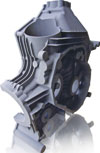

Additive manufacturing, also known as 3D printing, is an emerging cutting edge technology that is set to revolutionise manufacturing, and this includes hydraulic components.
Dubbed ‘the next trillion dollar industry’ by Business Insider, additive manufacturing (AM) ‘prints’ with materials such as thermopolymer, aluminium, titanium or stainless steel in a similar way to a laser printer. The process creates three-dimensional objects from a digital object using a materials printer. The solid object is built from a series of layers – each one printed directly on top of the previous one. CAD software slices the digital object into layers as thin as 10 microns. The 2D pattern of each layer is transmitted to the 3D printer, which extrudes, sprays, or spreads raw material onto a flat, horizontal platform. The material is cured, laser-sintered, fused, or bound by UV light, lasers, or electron beams. The process repeats until the object is fully formed.
The technique has been successfully applied for many years in the manufacture of prototypes and is now poised for ‘mass customization’. The additive approach to manufacturing reduces waste enormously, requiring as little as one tenth of the amount of material. It enables the production of a single item quickly and cheaply. It has the ability to create light, strong structures which have complex internal shapes and parts can be created in shapes that cannot be achieved with conventional techniques, resulting in new, more efficient designs.
Early adopters: aerospace and motor racing
Aircraft and racing car manufacturers have been among the early adopters of AM. Weight equates to cost in these industries and engineers can now digitally optimise density and other structural properties to manufacture customised, lightweight components such as impellers and fuel injection nozzles. One new design concept is an intake manifold for the Lotus racing car, which was produced by Evonik by laser sintering from polyamide 12 powder.
The Bloodhound SSC project, which is aiming to break the world land speed record with a car powered by a jet engine and a rocket, has showcased additive manufacturing in key components throughout the vehicle. These include the steering wheel, the auxiliary power unit gearbox housing, the high load parachute strop brackets and the bolt fixtures that will hold the carbon fibre front end to the metallic rear chassis.
In the field of aerospace, UAVs are also benefitting from AM technology. The CyberQuad is an Australian designed unmanned, electric, vertical take-off and landing system designed for urban reconnaissance. The quadrotor, which comprises four ducted rotors, is ‘printed’ using AM.
Engineers at the University of Southampton have designed and flown the world’s first printed aircraft, which could revolutionise the economics of aircraft design. The entire structure of the UAV was printed on a nylon laser sintering machine, including the wings, integral control surfaces, and access hatches. No fasteners were used and all equipment was attached using snap fit techniques so that the entire aircraft could be put together without tools in minutes.
Hydraulic components
The flow of hydraulic fluid in a gearbox is another potential application. According to Dr Ian Halliday, CEO of British engineering firm 3T RPD, by making a gearbox’s hydraulics using additive manufacturing, its weight can be reduced by 30%. The box will also change gear faster because the pathways through which the fluid flows can be made smoother. Like blood, hydraulic fluid flows better through smooth channels than ones filled with obstructions and sharp corners.
German company EOS supplied the laser sintering machine with which ACTech produced a hydraulic control valve for a rail vehicle. This had perfect switching properties due to tool-free core manufacturing with no demoulding angles. Simplification of the conventional casting mould was also achieved as parts of the outer contour were integrated into the core. Together with Italian company Poggipolini, EOS also created a fully functional part of a gearbox housing for motorcycles. This was achieved by laser sintering with titanium.
Another example is the Airbus A380, which has hydraulic valve housing in the wings which is a nightmare to produce, requiring complex machining. With 3D printing the part was designed based on achieving the best strength and performance, and was not restricted to design-for-manufacture principles.
For more information visit http://motioncontrol.co.za/+am

© Technews Publishing (Pty) Ltd | All Rights Reserved